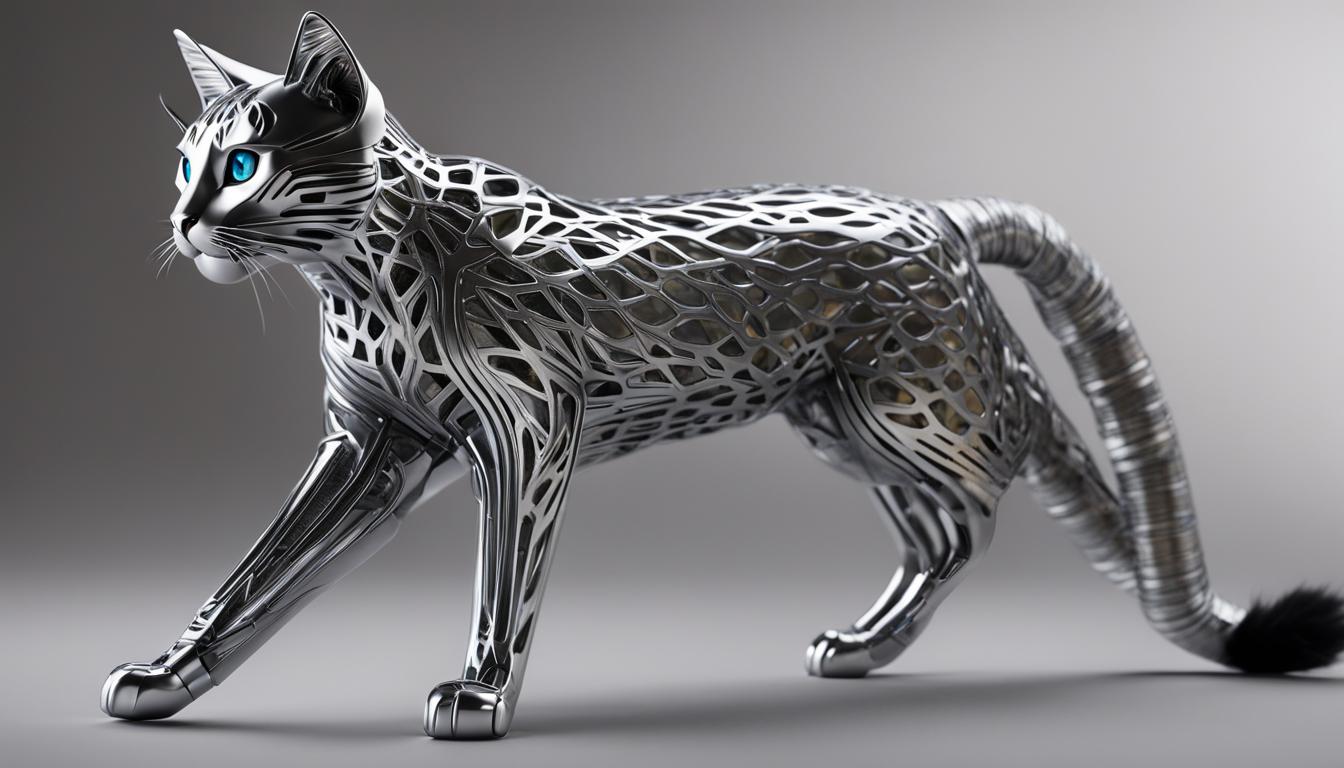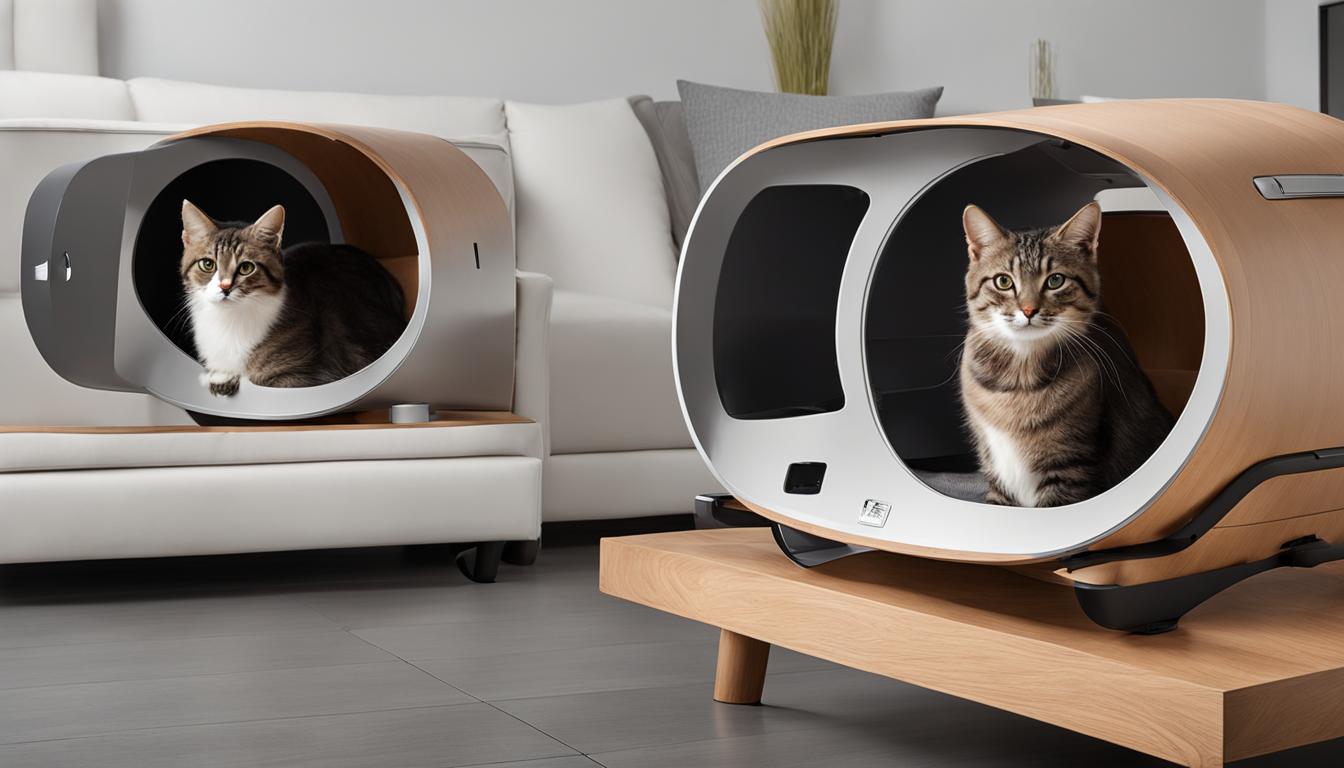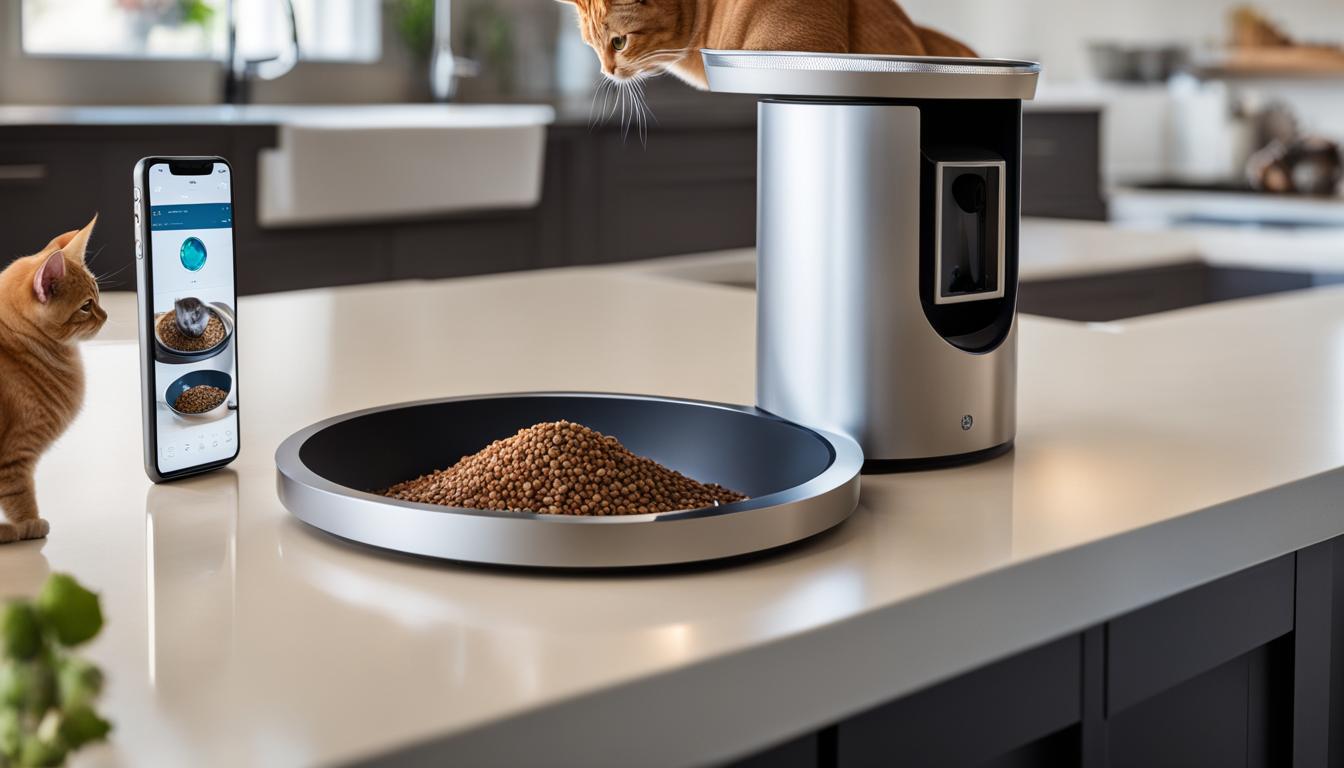As a cat lover and a tech enthusiast, I’ve always been fascinated by the incredible ways that technology can improve the lives of our furry friends. One particular area that has caught my attention is the field of 3D printing in veterinary orthopedics, specifically when it comes to creating custom prosthetics for cats.
Imagine a world where cats with mobility challenges can regain their freedom to roam and play, thanks to innovative 3D printed prosthetics. This groundbreaking technology has opened up new possibilities for creating personalized solutions that perfectly fit each cat’s unique needs.
One remarkable example of this is the work being done at the University of Nebraska-Lincoln. A team of talented students from the Biological Systems Engineering program successfully designed and produced a 3D printed prosthetic for Olive, a three-legged cat. This adjustable and non-toxic prosthetic, made primarily of polylactic acid (PLA) and a sturdy proprietary plastic, not only improved Olive’s mobility but also showed the potential for cost-effective solutions in the field.
Key Takeaways:
- 3D printing technology is making waves in the field of feline prosthetics.
- Custom 3D printed cat prosthetics provide personalized solutions for individual animals.
- The University of Nebraska-Lincoln has pioneered the development of 3D printed cat prosthetics.
- Polylactic acid (PLA) and other materials are used to create durable and adjustable prosthetics.
- Cost-effective 3D printing solutions are making prosthetics more accessible for cats in need.
Personalized 3D Printed Prosthetics for Cats
When it comes to cat prosthetics, one size does not fit all. That’s where personalized 3D printed prosthetics come in. These innovative designs are revolutionizing the world of cat prosthetics by providing bespoke solutions tailored specifically to each cat’s needs. With the help of 3D printing technology, cat owners like Karolyn Smith have been able to give their feline companions a second chance at mobility.
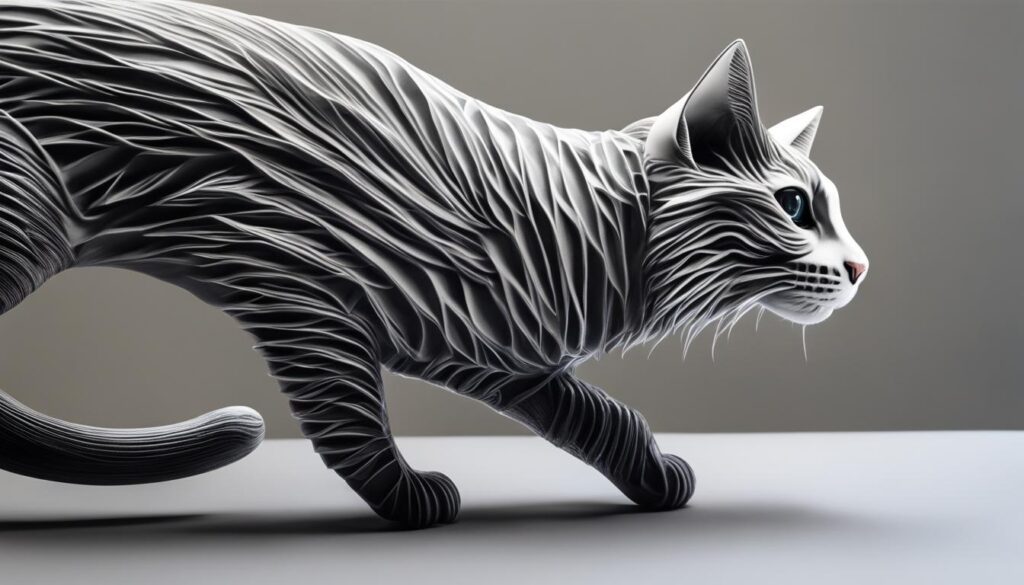
“The personalization allowed the prosthetic to provide the best fit and functionality for Sophia. This innovative approach to cat prosthetics showcases the potential for customized designs that cater to each individual animal’s needs.” – Karolyn Smith
Karolyn, an army veteran, used her own experiences with technology to create a custom-fit prosthetic leg for her cat Sophia. After Sophia’s leg amputation, Karolyn turned to 3D printing to design a prosthetic that would perfectly fit her furry friend. The result was a personalized prosthetic that not only improved Sophia’s mobility but also allowed her to engage in regular cat activities.
Innovative Cat Prosthetic Designs
One of the key advantages of 3D printed cat prosthetics is the ability to create innovative designs that replicate the functions of a natural paw. These designs go beyond basic functionality and take into account the unique needs and anatomy of each cat. By using a combination of materials, such as polylactic acid (PLA) and proprietary plastics, engineers are able to produce prosthetics that are adjustable, removable, non-toxic, and cost-effective.
| Advantages of Personalized 3D Printed Prosthetics for Cats | Examples of Innovative Cat Prosthetic Designs |
|---|---|
|
|
With personalized 3D printed prosthetics, cats like Sophia can regain their mobility and live fulfilling lives. The potential for customized designs combined with the advancements in 3D printing technology holds great promise for the future of cat prosthetics. As more cat owners and veterinarians embrace this innovative approach, we can expect to see even more remarkable designs and success stories in the world of feline limb prosthetics.
Advancements in 3D Printed Animal Prosthetics
3D printing technology has revolutionized the field of pet care, particularly in the development of advanced prosthetics for injured cats. This innovative approach has provided veterinarians and researchers with the ability to create customized orthopedic solutions that cater to each animal’s unique needs and anatomy. The impact of 3D printed animal prosthetics can be seen in the remarkable story of Dymka, a cat from Russia who received 3D-printed titanium prosthetic limbs.
Dymka suffered from frostbite, which led to the amputation of her legs. However, thanks to the team at Tomsk Polytechnic University, Dymka was given a second chance at mobility with 3D-printed titanium rods that were implanted into her leg bones. The use of CT scans allowed for precise measurements and the creation of prosthetics that perfectly fit Dymka’s anatomy. The prosthetics were also coated with calcium phosphate to aid in attachment and reduce the risk of infection. As a result, Dymka was able to adapt to her new legs and regain her mobility.
“The use of 3D printing technology has opened up new possibilities in the field of animal prosthetics,” says Dr. Sarah Thompson, a veterinary orthopedic specialist. “With the ability to create custom-fit prosthetics, we can now provide animals with enhanced mobility and improved quality of life.”
The advancements in 3D printed animal prosthetics not only provide practical solutions but also inspire hope for disabled cats and other animals worldwide. This technology has the potential to transform the lives of countless animals by restoring their ability to engage in regular activities and live fulfilling lives. As research and innovation in 3D printing continue to progress, we can expect to see even more remarkable advancements in the field of veterinary orthopedics.
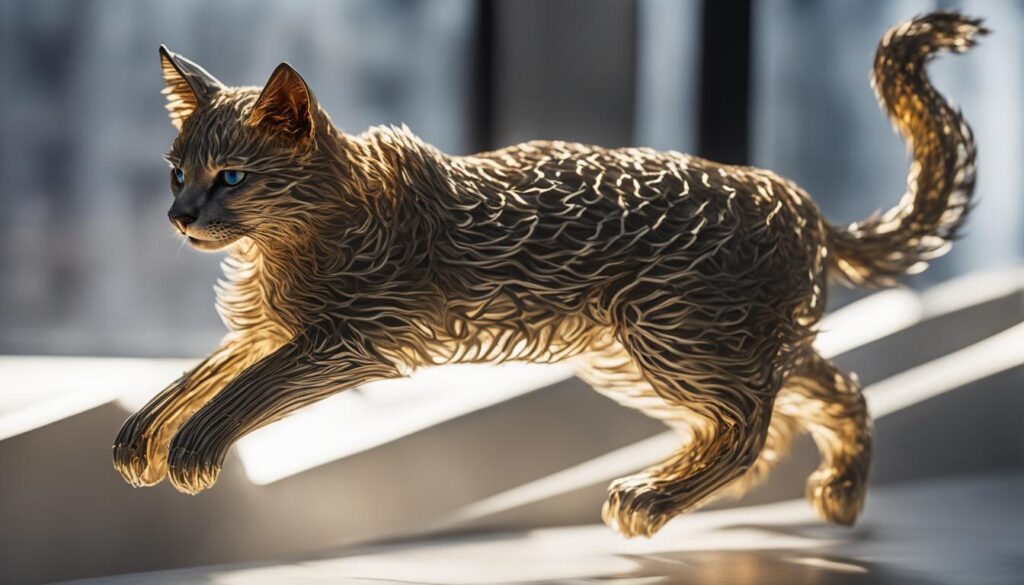
Table: Advancements in 3D Printed Animal Prosthetics
| Animal | Prosthetic | University/Institution |
|---|---|---|
| Olive | Adjustable and removable 3D printed prosthetic | University of Nebraska-Lincoln |
| Sophia | Custom-fit 3D printed prosthetic leg | Karolyn Smith |
| Dymka | 3D printed titanium prosthetic limbs | Tomsk Polytechnic University |
The Impact of 3D Printed Prosthetics on Animal Rehabilitation
3D printing technology has revolutionized the field of animal rehabilitation, providing a new level of hope and mobility for disabled pets. With the ability to create personalized and cost-effective prosthetic limbs, more animals are able to regain their independence and live fulfilling lives. Desktop 3D printing has made the production of pet prosthetics more accessible, allowing veterinarians and pet owners to create customized solutions in-house.
The success stories of animals like Olive, Sophia, and Dymka highlight the transformative power of 3D printed prosthetics. These innovative designs have allowed cats and other animals to overcome physical limitations and engage in regular activities. By creating prosthetics that are specifically tailored to each animal’s unique anatomy, 3D printing technology has opened up new possibilities in the field of veterinary orthopedics.
“The use of 3D printing technology in pet care has showcased the versatility and benefits of this technology,” says Dr. Sarah Reynolds, a veterinarian specializing in orthopedics. “With 3D printed pet prosthetics, we are able to provide animals with custom-fit solutions that greatly improve their quality of life.”
Improved Quality of Life for Disabled Pets
One of the key advantages of 3D printed prosthetics is the ability to create designs that are tailored to an animal’s specific needs and requirements. Traditional prosthetics can be bulky and uncomfortable, making it difficult for animals to adjust to their new limbs. However, 3D printed prosthetics can be customized to fit perfectly and provide optimal functionality.
| Advantages of 3D Printed Prosthetics for Animals | |
|---|---|
| Custom-fit designs | Provides a perfect fit for each individual animal, improving comfort and mobility |
| Cost-effective | Allows for affordable prosthetic solutions, making them accessible to a wider range of pet owners |
| Increased mobility | Enables animals to engage in regular activities and improve their overall quality of life |
| Quick production | With desktop 3D printing, prosthetics can be created in a timely manner, reducing wait times for animals in need |
The use of 3D printing technology in animal rehabilitation has had a profound impact on the lives of disabled pets. Not only does it provide them with a second chance at mobility, but it also improves their overall well-being and enhances their quality of life. As technology continues to advance and become more accessible, the future of pet prosthetics looks promising, offering hope and solutions for animals in need.
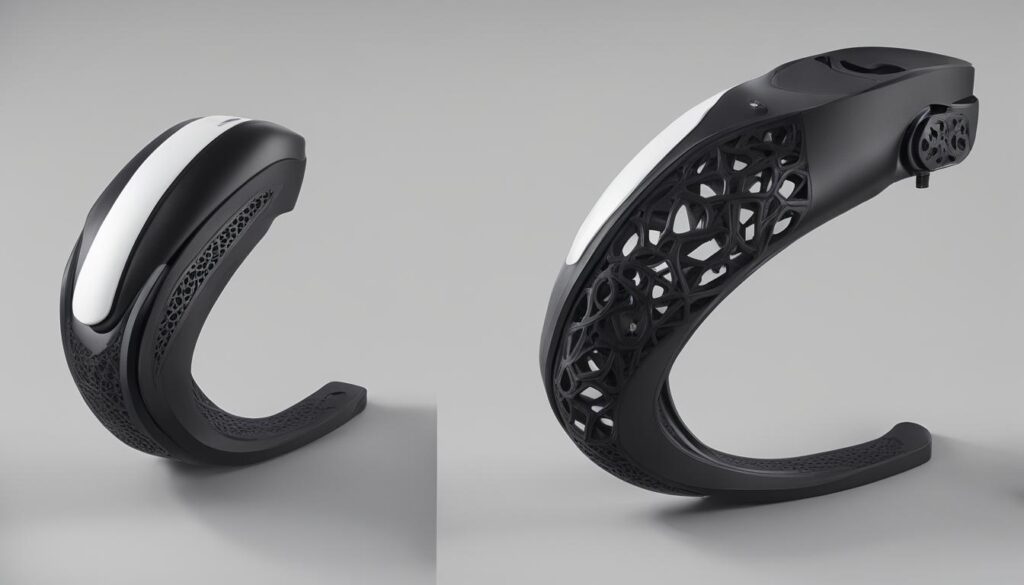
Conclusion
As I conclude my exploration of 3D printing innovations in feline prosthetics, I am truly amazed by the remarkable progress made in this field. The University of Nebraska-Lincoln, in collaboration with other pioneering institutions like Tomsk Polytechnic University, has played a crucial role in pushing the boundaries of what is possible in animal prosthetics.
Through their efforts, engineers and researchers have harnessed the power of 3D printing technology to create custom-fit and cost-effective prosthetic limbs for cats. The success stories of cats like Olive, Sophia, and Dymka serve as powerful reminders of the transformative impact that these innovative designs can have on the lives of disabled animals.
Looking ahead, the future of cat prosthetics appears bright. With ongoing advancements in 3D printing technology and the dedication of talented individuals at the University of Nebraska-Lincoln and beyond, we can expect to see even more groundbreaking developments in the field of veterinary orthopedics.
Ultimately, the application of 3D printing in cat prosthetics not only offers hope for disabled animals worldwide but also showcases the remarkable potential of human ingenuity and compassion to improve the lives of our furry companions.
FAQ
What is 3D printing?
3D printing is a manufacturing process that builds objects layer by layer using a digital design file. It allows for the creation of complex and customized shapes that traditional manufacturing methods cannot achieve.
How does 3D printing help in creating prosthetics for cats?
3D printing enables the production of custom-fit prosthetic limbs for cats by using digital scans or measurements of the animal’s anatomy. This personalized approach ensures a better fit and functionality for the prosthetic, improving the cat’s mobility.
What materials are used in 3D printed cat prosthetics?
The materials used in 3D printed cat prosthetics can vary, but commonly used materials include polylactic acid (PLA), a biodegradable and non-toxic plastic, and proprietary plastics that offer strength and durability.
How much does a 3D printed cat prosthetic cost?
The cost of a 3D printed cat prosthetic can vary depending on factors such as the size, complexity of the design, and the materials used. However, in many cases, 3D printed prosthetics for cats cost less than $100 to produce.
Can 3D printed cat prosthetics be removed and adjusted?
Yes, 3D printed cat prosthetics can be designed to be adjustable and removable. This allows for easy maintenance and adjustments as the cat’s needs change over time.
How are 3D printed cat prosthetics attached to the cat’s limb?
The attachment method for 3D printed cat prosthetics can vary depending on the design and the needs of the cat. Common methods include the use of Velcro straps, silicone sheathes, or implantation into bone for more permanent solutions.
Can 3D printed cat prosthetics be used for other animals?
Yes, 3D printing technology can be applied to create prosthetics for various animals, including dogs, rabbits, and even birds. The ability to customize and adapt the design makes 3D printing a versatile solution for animal prosthetics.

